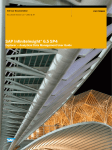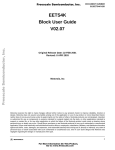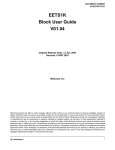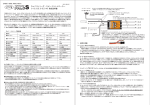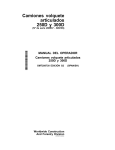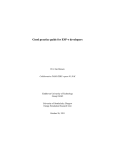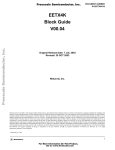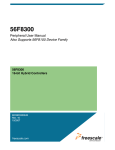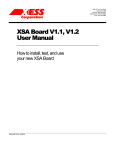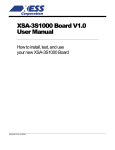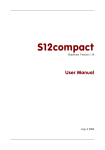Download FTS128K Block User Guide V02.01
Transcript
DOCUMENT NUMBER S12FTS128KV2/D FTS128K Block User Guide V02.01 Original Release Date: 19 JUL 2001 Revised: 8 APR 2003 Motorola, Inc Motorola reserves the right to make changes without further notice to any products herein to improve reliability, function or design. Motorola does not assume any liability arising out of the application or use of any product or circuit described herein; neither does it convey any license under its patent rights nor the rights of others. Motorola products are not designed, intended, or authorized for use as components in systems intended for surgical implant into the body, or other applications intended to support or sustain life, or for any other application in which the failure of the Motorola product could create a situation where personal injury or death may occur. Should Buyer purchase or use Motorola products for any such unintended or unauthorized application, Buyer shall indemnify and hold Motorola and its officers, employees, subsidiaries, affiliates, and distributors harmless against all claims, costs, damages, and expenses, and reasonable attorney fees arising out of, directly or indirectly, any claim of personal injury or death associated with such unintended or unauthorized use, even if such claim alleges that Motorola was negligent regarding the design or manufacture of the part. 1 FTS128K Block User Guide V02.01 Revision History Version Revision Effective Number Date Date Description of Changes V01.00 19JUL01 V01.01 04SEP01 Correct Table 3.2. V01.02 23NOV01 Add description of WRALL bit. Add descriptions of the Address and Data registers. V01.03 11MAR02 Modify document number. 29JUL02 Modify document number. Update security restrictions found in 4.5 Flash Security: (i) $0000 and $FFFF keys are illegal. (ii) No back-to-back writes of keys allowed. (iii) Writing more than 4 keys in a sequence will not unsecure. (iv) Incorrect key sequence results in lock-up with exit by reset only. V02.00 V02.01 2 08APR03 19JUL01 Author 29JUL02 Initial Version. Modify description of 3.3.5 FPROT — Flash Protection Register to clarify mass erase restrictions. Modify description of CBEIF and CCIF flags in 3.3.6 FSTAT — Flash Status Register. FTS128K Block User Guide V02.01 Table of Contents Section 1 Introduction 1.1 1.1.1 1.2 1.3 1.4 Overview. . . . . . . . . . . . . . . . . . . . . . . . . . . . . . . . . . . . . . . . . . . . . . . . . . . . . . . . . . . . . .9 Glossary . . . . . . . . . . . . . . . . . . . . . . . . . . . . . . . . . . . . . . . . . . . . . . . . . . . . . . . . . . . .9 Features . . . . . . . . . . . . . . . . . . . . . . . . . . . . . . . . . . . . . . . . . . . . . . . . . . . . . . . . . . . . . .9 Modes of Operation . . . . . . . . . . . . . . . . . . . . . . . . . . . . . . . . . . . . . . . . . . . . . . . . . . . .10 Block Diagram . . . . . . . . . . . . . . . . . . . . . . . . . . . . . . . . . . . . . . . . . . . . . . . . . . . . . . . .11 Section 2 External Signal Description 2.1 Overview. . . . . . . . . . . . . . . . . . . . . . . . . . . . . . . . . . . . . . . . . . . . . . . . . . . . . . . . . . . . .13 Section 3 Memory Map and Registers 3.1 Overview. . . . . . . . . . . . . . . . . . . . . . . . . . . . . . . . . . . . . . . . . . . . . . . . . . . . . . . . . . . . .15 3.2 Modules Memory Map . . . . . . . . . . . . . . . . . . . . . . . . . . . . . . . . . . . . . . . . . . . . . . . . . .15 3.3 Register Descriptions . . . . . . . . . . . . . . . . . . . . . . . . . . . . . . . . . . . . . . . . . . . . . . . . . . .19 3.3.1 FCLKDIV — Flash Clock Divider Register . . . . . . . . . . . . . . . . . . . . . . . . . . . . . . . . .19 3.3.2 FSEC — Flash Security Register. . . . . . . . . . . . . . . . . . . . . . . . . . . . . . . . . . . . . . . .19 3.3.3 FTSTMOD — Flash Test Mode Register . . . . . . . . . . . . . . . . . . . . . . . . . . . . . . . . . .21 3.3.4 FCNFG — Flash Configuration Register . . . . . . . . . . . . . . . . . . . . . . . . . . . . . . . . . .21 3.3.5 FPROT — Flash Protection Register . . . . . . . . . . . . . . . . . . . . . . . . . . . . . . . . . . . . .22 3.3.6 FSTAT — Flash Status Register . . . . . . . . . . . . . . . . . . . . . . . . . . . . . . . . . . . . . . . .24 3.3.7 FCMD — Flash Command Register . . . . . . . . . . . . . . . . . . . . . . . . . . . . . . . . . . . . .25 3.3.8 RESERVED1 . . . . . . . . . . . . . . . . . . . . . . . . . . . . . . . . . . . . . . . . . . . . . . . . . . . . . . .26 3.3.9 FADDR — Flash Address Register . . . . . . . . . . . . . . . . . . . . . . . . . . . . . . . . . . . . . .26 3.3.10 FDATA — Flash Data Register . . . . . . . . . . . . . . . . . . . . . . . . . . . . . . . . . . . . . . . . .27 3.3.11 RESERVED2 . . . . . . . . . . . . . . . . . . . . . . . . . . . . . . . . . . . . . . . . . . . . . . . . . . . . . . .28 3.3.12 RESERVED3 . . . . . . . . . . . . . . . . . . . . . . . . . . . . . . . . . . . . . . . . . . . . . . . . . . . . . . .28 3.3.13 RESERVED4 . . . . . . . . . . . . . . . . . . . . . . . . . . . . . . . . . . . . . . . . . . . . . . . . . . . . . . .28 3.3.14 RESERVED5 . . . . . . . . . . . . . . . . . . . . . . . . . . . . . . . . . . . . . . . . . . . . . . . . . . . . . . .29 Section 4 Functional Description 4.1 Program and Erase Operation . . . . . . . . . . . . . . . . . . . . . . . . . . . . . . . . . . . . . . . . . . . .31 4.1.1 Writing the FCLKDIV Register . . . . . . . . . . . . . . . . . . . . . . . . . . . . . . . . . . . . . . . . . .31 4.1.2 Program and Erase Sequences in User Mode. . . . . . . . . . . . . . . . . . . . . . . . . . . . . .34 3 FTS128K Block User Guide V02.01 4.1.3 4.1.4 4.2 4.3 4.4 4.5 4.5.1 Valid Flash Commands . . . . . . . . . . . . . . . . . . . . . . . . . . . . . . . . . . . . . . . . . . . . . . .36 Illegal Flash Operations . . . . . . . . . . . . . . . . . . . . . . . . . . . . . . . . . . . . . . . . . . . . . . .36 Wait Mode . . . . . . . . . . . . . . . . . . . . . . . . . . . . . . . . . . . . . . . . . . . . . . . . . . . . . . . . . . .37 Stop Mode . . . . . . . . . . . . . . . . . . . . . . . . . . . . . . . . . . . . . . . . . . . . . . . . . . . . . . . . . . .37 Background Debug Mode. . . . . . . . . . . . . . . . . . . . . . . . . . . . . . . . . . . . . . . . . . . . . . . .38 Flash Security. . . . . . . . . . . . . . . . . . . . . . . . . . . . . . . . . . . . . . . . . . . . . . . . . . . . . . . . .38 Unsecuring via the Backdoor Key Access . . . . . . . . . . . . . . . . . . . . . . . . . . . . . . . . .38 Section 5 Resets 5.1 General. . . . . . . . . . . . . . . . . . . . . . . . . . . . . . . . . . . . . . . . . . . . . . . . . . . . . . . . . . . . . .41 Section 6 Interrupts 6.1 6.2 General. . . . . . . . . . . . . . . . . . . . . . . . . . . . . . . . . . . . . . . . . . . . . . . . . . . . . . . . . . . . . .43 Description of Interrupt Operation . . . . . . . . . . . . . . . . . . . . . . . . . . . . . . . . . . . . . . . . .43 4 FTS128K Block User Guide V02.01 List of Figures Figure 1-1 Figure 3-1 Figure 3-2 Figure 3-3 Figure 3-4 Figure 3-5 Figure 3-6 Figure 3-7 Figure 3-8 Figure 3-9 Figure 3-10 Figure 3-11 Figure 3-12 Figure 3-13 Figure 3-14 Figure 3-15 Figure 3-16 Figure 3-17 Figure 4-1 Figure 4-2 Figure 6-1 Module Block Diagram. . . . . . . . . . . . . . . . . . . . . . . . . . . . . . . . . . . . . . . . . . . . .11 Flash Memory Map . . . . . . . . . . . . . . . . . . . . . . . . . . . . . . . . . . . . . . . . . . . . . . .16 Flash Clock Divider Register (FCLKDIV). . . . . . . . . . . . . . . . . . . . . . . . . . . . . . .19 Flash Security Register (FSEC). . . . . . . . . . . . . . . . . . . . . . . . . . . . . . . . . . . . . .19 Flash Test Mode Register (FTSTMOD). . . . . . . . . . . . . . . . . . . . . . . . . . . . . . . .21 Flash Configuration Register (FCNFG) . . . . . . . . . . . . . . . . . . . . . . . . . . . . . . . .21 Flash Protection Register (FPROT). . . . . . . . . . . . . . . . . . . . . . . . . . . . . . . . . . .22 Flash Status Register (FSTAT) . . . . . . . . . . . . . . . . . . . . . . . . . . . . . . . . . . . . . .24 Flash Command Buffer and Register (FCMD). . . . . . . . . . . . . . . . . . . . . . . . . . .25 RESERVED1 . . . . . . . . . . . . . . . . . . . . . . . . . . . . . . . . . . . . . . . . . . . . . . . . . . . .26 Flash Address High Register (FADDRHI) . . . . . . . . . . . . . . . . . . . . . . . . . . . . . .26 Flash Address Low Register (FADDRLO) . . . . . . . . . . . . . . . . . . . . . . . . . . . . . .27 Flash Data High Register (FDATAHI) . . . . . . . . . . . . . . . . . . . . . . . . . . . . . . . . .27 Flash Data Low Register (FDATALO) . . . . . . . . . . . . . . . . . . . . . . . . . . . . . . . . .27 RESERVED2 . . . . . . . . . . . . . . . . . . . . . . . . . . . . . . . . . . . . . . . . . . . . . . . . . . . .28 RESERVED3 . . . . . . . . . . . . . . . . . . . . . . . . . . . . . . . . . . . . . . . . . . . . . . . . . . . .28 RESERVED4 . . . . . . . . . . . . . . . . . . . . . . . . . . . . . . . . . . . . . . . . . . . . . . . . . . . .28 RESERVED5 . . . . . . . . . . . . . . . . . . . . . . . . . . . . . . . . . . . . . . . . . . . . . . . . . . . .29 PRDIV8 and FDIV bits Determination Procedure . . . . . . . . . . . . . . . . . . . . . . . .33 Example Program Algorithm . . . . . . . . . . . . . . . . . . . . . . . . . . . . . . . . . . . . . . . .35 FTS128K Flash Interrupt Implementation . . . . . . . . . . . . . . . . . . . . . . . . . . . . . .44 5 FTS128K Block User Guide V02.01 6 FTS128K Block User Guide V02.01 List of Tables Table 3-1 Table 3-2 Table 3-3 Table 3-4 Table 3-5 Table 3-6 Table 3-7 Table 3-8 Table 3-9 Table 3-10 Table 4-1 Table 6-1 Flash Protection/Options Field. . . . . . . . . . . . . . . . . . . . . . . . . . . . . . . . . . . . . . .15 Flash Memory Map Summary . . . . . . . . . . . . . . . . . . . . . . . . . . . . . . . . . . . . . . .17 Flash Register Memory Map . . . . . . . . . . . . . . . . . . . . . . . . . . . . . . . . . . . . . . . .18 Flash KEYEN States . . . . . . . . . . . . . . . . . . . . . . . . . . . . . . . . . . . . . . . . . . . . . .20 Flash Security States. . . . . . . . . . . . . . . . . . . . . . . . . . . . . . . . . . . . . . . . . . . . . .20 Flash Register Bank Selects . . . . . . . . . . . . . . . . . . . . . . . . . . . . . . . . . . . . . . . .22 Loading of the Protection Register from Flash . . . . . . . . . . . . . . . . . . . . . . . . . .22 Flash Higher Address Range Protection . . . . . . . . . . . . . . . . . . . . . . . . . . . . . . .23 Flash Lower Address Range Protection . . . . . . . . . . . . . . . . . . . . . . . . . . . . . . .24 Flash Normal Mode Commands . . . . . . . . . . . . . . . . . . . . . . . . . . . . . . . . . . . . .26 Valid Flash Commands . . . . . . . . . . . . . . . . . . . . . . . . . . . . . . . . . . . . . . . . . . . .36 Flash Interrupt Sources . . . . . . . . . . . . . . . . . . . . . . . . . . . . . . . . . . . . . . . . . . . .43 7 FTS128K Block User Guide V02.01 8 FTS128K Block User Guide V02.01 Section 1 Introduction 1.1 Overview This document describes the FTS128K module which is a 128K byte Flash (Non-Volatile) memory. The Flash memory contains 2 blocks of 64K bytes with each block organized as 1024 rows of 64 bytes. The Flash block’s erase sector size is 8 rows (512 bytes). The Flash memory may be read as either bytes, aligned words or misaligned words. Read access time is one bus cycle for byte and aligned word, and two bus cycles for misaligned words. Program and erase functions are controlled by a command driven interface. Both sector erase and mass erase of an entire 64K byte Flash block are supported. An erased bit reads ’1’ and a programmed bit reads ’0’. The high voltage required to program and erase is generated internally by on-chip charge pumps. Each Flash block can be programmed or erased at the same time. However, it is not possible to read from a Flash block while it is being erased or programmed. The Flash memory is ideal for program and data storage for single-supply applications allowing for field reprogramming without requiring external programming voltage sources. WARNING A word must be erased before being programmed. Cumulative programming of bits within a word is not allowed. 1.1.1 Glossary Banked Register A register operating on one Flash block which shares the same register address as the equivalent registers for the other Flash block. The active register bank is selected by a bank-select bit in the unbanked register space. Common Register A register which operates on all Flash blocks. Command Sequence A three-step MCU instruction sequence to program, erase or erase-verify a Flash block. 1.2 Features • 128K bytes of flash memory comprising two 64k byte blocks. • Each block in the Flash module can be read, programmed or erased concurrently. 9 FTS128K Block User Guide V02.01 • Automated program and erase algorithm. • Interrupts on Flash command completion and command buffer empty. • Fast sector erase and word program operation. • 2-stage command pipeline. • Flexible protection scheme for protection against accidental program or erase. • Single power supply program and erase. • Security feature. 1.3 Modes of Operation • 10 Program and erase operation (please refer to 4.1 for details). FTS128K Block User Guide V02.01 1.4 Block Diagram Figure 1-1 shows a block diagram of the FTS128K module. FTS128K Command Interface Common Registers Command Complete Interrupt Command Buffer Empty Interrupt Flash-0 Array 32k * 16 Bits row0 row1 Banked Registers row1023 Command Pipelines Flash 0-1 comm2 addr2 data2 comm1 addr1 data1 Protection Flash-1 Array 32k * 16 Bits row0 row1 Security row1023 Oscillator Clock Clock Divider FCLK Figure 1-1 Module Block Diagram 11 FTS128K Block User Guide V02.01 12 FTS128K Block User Guide V02.01 Section 2 External Signal Description 2.1 Overview The FTS128K module contains no signals that connect off-chip. 13 FTS128K Block User Guide V02.01 14 FTS128K Block User Guide V02.01 Section 3 Memory Map and Registers 3.1 Overview This section describes the FTS128K memory map and registers. 3.2 Modules Memory Map Figure 3-1shows the FTS128K memory map. The HCS12 architecture places the Flash array addresses between $4000 and $FFFF, which corresponds to three 16K byte pages.1 The content of the HCS12 Core PPAGE register is used to map the logical middle page ranging from address $8000 to $BFFF to any physical 16K byte page in the physical memory.2 Shown within the pages are a protection/options field, described in Table 3-1,and user defined Flash protected sectors, describe in Table 3-2. The FPOPEN bit in the FPROT register (see 3.3.5) can globally protect the entirety of the corresponding Flash block. However, for both Flash blocks, two protected areas, one starting from the Flash block starting address (called lower) towards higher addresses and the other one growing downward from the Flash block end address (called higher) can be activated. For Flash block 0, the higher page is mainly targeted to hold the boot loader code since it covers the vector space. Security information that allows the MCU to prevent intrusive access to the Flash module is stored in the Flash Protection/Options field of Flash block 0 as described in Table 3-1. Table 3-1 Flash Protection/Options Field Array Address Size (bytes) Description $FF00 - $FF07 8 Backdoor Comparison Keys $FF08 - $FF0B 4 Reserved $FF0C 1 Block 1 Flash Protection byte Refer to Section 3.3.5 $FF0D 1 Block 0 Flash Protection byte Refer to Section 3.3.5 $FF0E 1 Reserved $FF0F 1 Flash Options/Security byte Refer to Section 3.3.2 NOTES: 1. Some MCU memory maps may provide the ability to enable an additional 16k byte page from $0000 to $3FFF. 2. By placing $3F or $3E in the PPAGE register, the bottom respectively top “fixed” 16Kbytes pages can be seen twice in the MCU memory map. 15 FTS128K Block User Guide V02.01 (16 bytes) REGISTER BASE + $100 Flash Registers REGISTER BASE + $10F FLASH_START = $4000 $4200 $4400 Flash Protected Low Sectors 0.5K, 1K, 2K, 4K bytes $4800 $5000 $3E 12K Flash Array $8000 16K PAGED MEMORY $38 $39 $3A $3B $3C Block 1 $3D Block 0 $C000 $E000 $3F Flash Protected High Sectors 2K, 4K, 8K, 16K bytes $F000 $F800 FLASH_END = $FFFF $FF00 - $FF0F, Flash Protection/Security Field Two Blocks of Flash IP Note: $38-$3F correspond to the PPAGE register content Figure 3-1 Flash Memory Map 16 $3E $3F FTS128K Block User Guide V02.01 Table 3-2 Flash Memory Map Summary MCU Address Range PPAGE Protectable Low Range Protectable High Range Flash Block Block Relative Address1 $0000-$3FFF2 Unpaged ($3D) N.A. N.A. 0 $4000-$7FFF N.A. 0 $8000-$BFFF $4000-$41FF $4000-$7FFF Unpaged ($3E) $4000-$43FF $4000-$47FF $4000-$4FFF $38 N.A. N.A. $0000-$3FFF $39 N.A. N.A. $4000-$7FFF N.A. $8000-$BFFF $8000-$81FF $3A $8000-$83FF $8000-$87FF 1 $8000-$8FFF $B800-$BFFF $3B $8000-$BFFF N.A. $B000-$BFFF $C000-$FFFF $A000-$BFFF $8000-$BFFF $3C N.A. N.A. $0000-$3FFF $3D N.A. N.A. $4000-$7FFF N.A. $8000-$BFFF $8000-$81FF $3E $8000-$83FF $8000-$87FF 0 $8000-$8FFF $B800-$BFFF $3F N.A. $B000-$BFFF $C000-$FFFF $A000-$BFFF $8000-$BFFF $F800-$FFFF $C000-$FFFF Unpaged ($3F) N.A. $F000-$FFFF $E000-$FFFF 0 $C000-$FFFF $C000-$FFFF NOTES: 1. Inside each Flash block. 2. If allowed by MCU. 17 FTS128K Block User Guide V02.01 The Flash module also contains a set of 16 control and status registers located in address space BASE + $100 to BASE + $10F. In order to accommodate two Flash blocks with a minimum register address space, a set of registers (BASE+$104 to BASE+$10B) is duplicated in two banks. The active bank is selected by the BKSEL bit in the unbanked Flash Configuration Register (FCNFG). A summary of these registers is given in Table 3-3. Table 3-3 Flash Register Memory Map Address Offset Use Access $_00 Flash Clock Divider Register (FCLKDIV) R/W $_01 Flash Security Register (FSEC) R 1 $_02 Flash Test Mode Register (FTSTMOD) R $_03 Flash Configuration Register (FCNFG) R/W $_04 Flash Protection Register (FPROT) R/W $_05 Flash Status Register (FSTAT) R/W $_06 Flash Command Register (FCMD) R/W $_07 RESERVED11 R $_08 Flash High Address Register (FADDRHI)1 R $_09 (FADDRLO)1 R $_0A $_0B Flash Low Address Register (FDATAHI)1 R (FDATALO)1 R Flash High Data Register Flash Low Data Register $_0C RESERVED21 R $_0D RESERVED31 R $_0E RESERVED41 R $_0F RESERVED51 R NOTES: 1. Intended for factory test purposes only. NOTE: 18 Register Address = Register Base Address + $100 + Address Offset, where the Register Base Address is defined by the HCS12 Core INITRG register and the Address Offset is defined by the Flash module. FTS128K Block User Guide V02.01 3.3 Register Descriptions 3.3.1 FCLKDIV — Flash Clock Divider Register The unbanked FCLKDIV register is used to control timed events in program and erase algorithms. Register address BASE + $100 7 R W RESET: FDIVLD 0 6 5 4 3 2 1 0 PRDIV8 FDIV5 FDIV4 FDIV3 FDIV2 FDIV1 FDIV0 0 0 0 0 0 0 0 = Unimplemented or Reserved Figure 3-2 Flash Clock Divider Register (FCLKDIV) All bits in the FCLKDIV register are readable, bits 6-0 are write once and bit 7 is not writable. FDIVLD — Clock Divider Loaded. 1 = Register has been written to since the last reset. 0 = Register has not been written. PRDIV8 — Enable Prescaler by 8. 1 = Enables a prescaler by 8, to divide the Flash module input oscillator clock before feeding into the CLKDIV divider. 0 = The input oscillator clock is directly fed into the FCLKDIV divider. FDIV[5:0] — Clock Divider Bits. The combination of PRDIV8 and FDIV[5:0] effectively divides the Flash module input oscillator clock down to a frequency of 150kHz - 200kHz. The maximum divide ratio is 512. Please refer to section 4.1.1 for more information. 3.3.2 FSEC — Flash Security Register This unbanked FSEC register holds all bits associated with the security of the MCU. Register address BASE + $101 R W Reset: 7 KEYEN1 6 KEYEN0 5 NV5 4 NV4 3 NV3 2 NV2 1 SEC1 0 SEC0 F F F F F F F F = Unimplemented or Reserved Figure 3-3 Flash Security Register (FSEC) All bits in the FSEC register are readable but not writable. 19 FTS128K Block User Guide V02.01 The FSEC register is loaded from the Flash Protection/Options field byte at $FF0F during the reset sequence, indicated by “F” in Figure 3-3. KEYEN[1:0]— Backdoor Key Security Enable Bits. The KEYEN[1:0] bits define the enabling of the Backdoor Key Access to the Flash module as shown in Table 3-4. Table 3-4 Flash KEYEN States KEYEN[1:0] Description 00 Backdoor Key Access to Flash module DISABLED 01 Backdoor Key Access to Flash module DISABLED 10 Backdoor Key Access to Flash module ENABLED 11 Backdoor Key Access to Flash module DISABLED NV[5:2] — Non-Volatile Flag Bits. These 4 bits are available to the user as non-volatile flags. SEC[1:0] — Flash Security Bits. The SEC[1:0] bits define the security state of the MCU as shown in Table 3-5. If the Flash module is unsecured using the Backdoor Key Access, the SEC bits are forced to “10”. Table 3-5 Flash Security States SEC[1:0] Description 00 secured 01 secured 10 unsecured 11 secured The security function in the Flash module is described in section 4.5. 20 FTS128K Block User Guide V02.01 3.3.3 FTSTMOD — Flash Test Mode Register The unbanked FTSTMOD register is used primarily to control the Flash special modes. Register address BASE + $102 7 6 5 4 R W N/A N/A N/A WRALL Reset: 0 0 0 0 3 2 1 0 0 0 0 0 0 0 N/A 0 = Unimplemented or Reserved Figure 3-4 Flash Test Mode Register (FTSTMOD) In normal modes, all bits in the FTSTMOD register read zero and are not writable. The WRALL bit is writable only in special modes. The purpose of this bit is to launch a command on all blocks in parallel. This can be useful for mass erase and erase verify operations. All other bits in this register must be written to zero at all times. WRALL —Write to all register banks. If this bit is set, all banked registers sharing the same address will be written simultaneously. 1 = Write to all register banks. 0 = Write only to the bank selected via BKSEL. 3.3.4 FCNFG — Flash Configuration Register The unbanked FCNFG register enables the Flash interrupts, gates the security backdoor writes and selects the register bank to be operated on. Register address BASE + $103 7 6 5 R W CBEIE CCIE KEYACC Reset: 0 0 0 4 3 2 1 0 0 0 0 0 0 0 0 0 BKSEL 0 = Unimplemented or Reserved Figure 3-5 Flash Configuration Register (FCNFG) CBEIE, CCIE, KEYACC and BKSEL are readable and writable. Bits 4-1 read zero and are not writable. CBEIE — Command Buffer Empty Interrupt Enable. The CBEIE bit enables the interrupts in case of an empty command buffer in the Flash module. 1 = An interrupt will be requested whenever the CBEIF flag, Figure 3-7, is set. 0 = Command Buffer Empty interrupts disabled. 21 FTS128K Block User Guide V02.01 CCIE — Command Complete Interrupt Enable. The CCIE bit enables the interrupts in case of all commands being completed in the Flash module. 1 = An interrupt will be requested whenever the CCIF, Figure 3-7, flag is set. 0 = Command Complete interrupts disabled. KEYACC — Enable Security Key Writing. 1 = Writes to Flash array are interpreted as keys to open the backdoor. Reads of the Flash array return invalid data. 0 = Flash writes are interpreted as the start of a program or erase sequence. BKSEL — Register Bank Select. This bit is used to select one of the two register banks. The register bank associated with Flash 0 is the default out of reset. The bank selection is according to Table 3-6. Table 3-6 Flash Register Bank Selects BKSEL Selected Register Bank 0 Flash 0 1 Flash 1 3.3.5 FPROT — Flash Protection Register The banked FPROT register defines which Flash sectors are protected against program or erase. Register address BASE + $104 7 6 5 4 3 2 1 0 R W FPOPEN NV6 FPHDIS FPHS1 FPHS0 FPLDIS FPLS1 FPLS0 Reset: F F F F F F F F = Unimplemented or Reserved Figure 3-6 Flash Protection Register (FPROT) The FPROT register is readable in normal and special modes. Bit NV6 is not writable. FPOPEN, FPHDIS and FPLDIS bits in the FPROT register can only be written to the protected state (i.e. 0). FPLS[1:0] can be written anytime until bit FPLDIS is cleared. FPHS[1:0] bits can be written anytime until bit FPHDIS is cleared. If the FPOPEN bit is cleared, then the state of the FPHDIS, FPHS[1:0], FPLDIS and FPLS[1:0] bits is irrelevant. The FPROT register is loaded from Flash block 0 during reset as shown in Table 3-7. Table 3-7 Loading of the Protection Register from Flash 22 Flash Address Protection byte for $FF0D Flash 0 $FF0C Flash 1 FTS128K Block User Guide V02.01 To change the Flash protection that will be loaded on reset, the upper sector of Flash block 0 must be unprotected, then the Flash Protect/Security byte located as described in Table 3-1 must be written to. A protected Flash sector is disabled by the bits FPHDIS and FPLDIS while the size of the protected sector is defined by FPHS[1:0] and FPLS[1:0] in the FPROT register. Trying to alter any of the protected areas will result in a protect violation error and PVIOL flag will be set in the FSTAT register. A mass erase of a whole Flash block is only possible when protection is fully disabled by setting the FPOPEN, FPLDIS, and FPHDIS bits. An attempt to mass erase a Flash block while protection is enabled in that block will set the PVIOL flag in the FSTAT register. FPOPEN — Opens the Flash for program or erase. 1 = The Flash sectors not protected are enabled for program or erase. 0 = The whole Flash block is protected. In this case the FPHDIS, FPHS[1:0], FPLDIS and FPLS[1:0] bits within the protection register are ignored. FPHDIS — Flash Protection Higher address range Disable. The FPHDIS bit determines whether there is a protected area in the higher space of the Flash block. 1 = Protection disabled. 0 = Protection enabled. FPHS[1:0] — Flash Protection Higher Address Size. The FPHS[1:0] bits determine the size of the protected sector. Refer to Table 3-8. Table 3-8 Flash Higher Address Range Protection FPHS Protected Address Range 00 Protected Size 2K bytes 01 4K see Table 3-2 10 8K 11 16K FPLDIS — Flash Protection Lower address range Disable. The FPLDIS bit determines whether there is a protected sector in the lower space of the Flash block. 1 = Protection disabled. 0 = Protection enabled. FPLS[1:0] — Flash Protection Lower Address Size. The FPLS[1:0] bits determine the size of the protected sector. Refer to Table 3-9. 23 FTS128K Block User Guide V02.01 Table 3-9 Flash Lower Address Range Protection Protected Address Range FPLS Protected Size 00 512 Bytes 01 1K see Table 3-2 10 2K 11 4K NV6 — Non-Volatile Flag Bit. The NV6 bit should remain in the erased state “1” for future enhancements. 3.3.6 FSTAT — Flash Status Register The banked FSTAT register defines the Flash state machine command status and Flash array access, protection and erase verify status. Register address BASE + $105 7 R W CBEIF Reset: 1 6 CCIF 1 5 4 PVIOL ACCERR 0 0 3 2 1 0 0 BLANK 0 0 0 0 0 0 = Unimplemented or Reserved Figure 3-7 Flash Status Register (FSTAT) Register bits CBEIF, PVIOL and ACCERR are readable and writable, bits CCIF and BLANK are readable and not writable, bits 3, 1 and 0 read zero and are not writable. CBEIF — Command Buffer Empty Interrupt Flag. The CBEIF flag indicates that the address, data and command buffers are empty so that a new command sequence can be started. The CBEIF flag is cleared by writing a “1” to CBEIF. Writing a "0" to CBEIF after writing an aligned word to the Flash address space but before CBEIF is cleared will abort a command sequence and cause the ACCERR flag in the FSTAT register to be set. Writing a "0" to CBEIF outside of a command sequence will not set the ACCERR flag. The CBEIF flag is used together with the CBEIE bit in the FCNFG register to generate an interrupt request (see also Figure 6-1). 1 = Buffers are ready to accept a new command. 0 = Buffers are full. CCIF — Command Complete Interrupt Flag. 24 FTS128K Block User Guide V02.01 The CCIF flag indicates that there are no more commands pending. The CCIF flag is cleared when CBEIF is clear and sets automatically upon completion of all active and pending commands. The CCIF flag does not set when an active commands completes and a pending command is fetched from the command buffer. Writing to the CCIF flag has no effect. The CCIF flag is used together with the CCIE bit in the FCNFG register to generate an interrupt request (see also Figure 6-1). 1 = All commands are completed. 0 = Command in progress. PVIOL — Protection Violation. The PVIOL flag indicates an attempt was made to program or erase an address in a protected Flash memory area. The PVIOL flag is cleared by writing a “1” to PVIOL. Writing a “0” to the PVIOL flag has no effect on PVIOL. While PVIOL is set in either of the FSTAT registers, it is not possible to launch another command in either of the Flash blocks. 1 = A protection violation has occurred. 0 = No failure. ACCERR — Flash Access Error. The ACCERR flag indicates an illegal access to the selected Flash block caused by either a violation of the command sequence, issuing an illegal command (illegal combination of the CMDBx bits in the FCMD register) or the execution of a CPU STOP instruction while a command is executing (CCIF=0). The ACCERR flag is cleared by writing a “1” to ACCERR. Writing a “0” to the ACCERR flag has no effect on ACCERR. While ACCERR is set in either of the FSTAT registers, it is not possible to launch another command in either of the Flash blocks. 1 = Access error has occurred. 0 = No failure. BLANK — Array has been verified as erased. The BLANK flag indicates that an erase verify command has checked the Flash block and found it to be erased. The BLANK flag is cleared by hardware when CBEIF is cleared as part of a new valid command sequence. Writing to the BLANK flag has no effect on BLANK. 1 = Flash block verifies as erased. 0 = If an erase verify command has been requested, and the CCIF flag is set, then a zero in BLANK indicates the block is not erased. 3.3.7 FCMD — Flash Command Register The banked FCMD register defines the Flash commands. Register address BASE + $106 7 R W 0 Reset: 0 6 5 CMDB6 CMDB5 0 0 4 3 0 0 0 0 2 CMDB2 0 1 0 0 0 CMDB0 0 = Unimplemented or Reserved Figure 3-8 Flash Command Buffer and Register (FCMD) 25 FTS128K Block User Guide V02.01 Bits 7, 4, 3 and 1 read zero and are not writable. Bits CMDB6, CMDB5, CMDB2 and CMDB0 are readable and writable during a command sequence. CMDB — Valid normal mode commands are shown in Table 3-10. Any commands other than those mentioned in Table 3-10 sets the ACCERR bit in the FSTAT register (3.3.6). Table 3-10 Flash Normal Mode Commands Command Meaning $05 Erase Verify $20 Word Program $40 Sector Erase $41 Mass Erase 3.3.8 RESERVED1 This register is reserved for factory testing and is not accessible to the user. Register address BASE + $107 7 6 5 4 3 2 1 0 R W 0 0 0 0 0 0 0 0 Reset: 0 0 0 0 0 0 0 0 10 9 8 0 0 0 = Unimplemented or Reserved Figure 3-9 RESERVED1 All bits read zero and are not writable. 3.3.9 FADDR — Flash Address Register FADDRHI and FADDRLO are the banked Flash address registers. Register address Base + $108 15 R W 0 Reset: 0 14 13 12 11 FABHI 0 0 0 0 = Unimplemented or Reserved Figure 3-10 Flash Address High Register (FADDRHI) 26 FTS128K Block User Guide V02.01 Register address Base + $109 15 14 13 12 R W Reset: 11 10 9 8 0 0 0 0 FABLO 0 0 0 0 Figure 3-11 Flash Address Low Register (FADDRLO) In normal modes, the FADDR (FADDRHI, FADDRLO) register reads zeros and is not writable. The unused bits in register FADDRHI (gray shaded bit positions in Figure 3-10) read zero and are not writable. The FADDRHI and FADDRLO registers can be written in special modes by writing to address BASE + $108 and BASE + $109 in the register space. For sector erase, the MCU address bits AB[8:0] are ignored. For mass erase, any address within the block is valid to start the command. 3.3.10 FDATA — Flash Data Register FDATAHI and FDATALO are the banked Flash data registers. Register address BASE + $10A 7 6 5 4 R W Reset: 3 2 1 0 0 0 0 0 FDHI 0 0 0 0 Figure 3-12 Flash Data High Register (FDATAHI) Register address BASE + $10B 7 6 5 4 R W Reset: 3 2 1 0 0 0 0 0 FDLO 0 0 0 0 Figure 3-13 Flash Data Low Register (FDATALO) In normal modes, all FDATA bits read zero and are not writable. In special modes, all FDATA bits are readable and writable when writing to an address within the Flash address range. 27 FTS128K Block User Guide V02.01 3.3.11 RESERVED2 This register is reserved for factory testing and is not accessible to the user. Register address BASE + $10C 7 6 5 4 3 2 1 0 R W 0 0 0 0 0 0 0 0 Reset: 0 0 0 0 0 0 0 0 = Unimplemented or Reserved Figure 3-14 RESERVED2 All bits read zero and are not writable. 3.3.12 RESERVED3 This register is reserved for factory testing and is not accessible to the user. Register address BASE + $10D 7 6 5 4 3 2 1 0 R W 0 0 0 0 0 0 0 0 Reset: 0 0 0 0 0 0 0 0 = Unimplemented or Reserved Figure 3-15 RESERVED3 All bits read zero and are not writable. 3.3.13 RESERVED4 This register is reserved for factory testing and is not accessible to the user. Register address BASE + $10E 7 6 5 4 3 2 1 0 R W 0 0 0 0 0 0 0 0 Reset: 0 0 0 0 0 0 0 0 = Unimplemented or Reserved Figure 3-16 RESERVED4 All bits read zero and are not writable. 28 FTS128K Block User Guide V02.01 3.3.14 RESERVED5 This register is reserved for factory testing and is not accessible to the user. Register address BASE + $10F 7 6 5 4 3 2 1 0 R W 0 0 0 0 0 0 0 0 Reset: 0 0 0 0 0 0 0 0 = Unimplemented or Reserved Figure 3-17 RESERVED5 All bits read zero and are not writable. 29 FTS128K Block User Guide V02.01 30 FTS128K Block User Guide V02.01 Section 4 Functional Description 4.1 Program and Erase Operation Write and read operations are both used for the program and erase algorithms described in this section. These algorithms are controlled by a state machine whose timebase FCLK is derived from the oscillator clock via a programmable divider. The command register as well as the associated address and data registers operate as a buffer and a register (2-stage FIFO) so that a new command along with the necessary data and address can be stored to the buffer while the previous command is still in progress. This pipelined operation allows a time optimization when programming more than one word on a specific row, as the high voltage generation can be kept ON in between two programming commands. The pipelined operation also allows a simplification of command launching. Buffer empty as well as command completion are signalled by flags in the Flash status register. Interrupts for the Flash will be generated if enabled. The next four subsections describe: • How to write the FCLKDIV register. • The write sequences used to program, erase and erase-verify the Flash. • Valid Flash commands. • Errors resulting from illegal Flash operations. 4.1.1 Writing the FCLKDIV Register Prior to issuing any program or erase command, it is first necessary to write the FCLKDIV register to divide the oscillator down to within the 150kHz to 200kHz range. The program and erase timings are also a function of the bus clock, such that the FCLKDIV determination must take this information into account. If we define: • FCLK as the clock of the Flash timing control block • Tbus as the period of the bus clock • INT(x) as taking the integer part of x (e.g. INT(4.323)=4), then FCLKDIV register bits PRDIV8 and FDIV[5:0] are to be set as described in Figure 4-1. For example, if the oscillator clock frequency is 950kHz and the bus clock is 10MHz, FCLKDIV bits FDIV[5:0] should be set to 4 (000100) and bit PRDIV8 set to 0. The resulting FCLK is then 190kHz. As a result, the Flash algorithm timings are increased over optimum target by: ( 200 – 190 ) ⁄ 200 × 100 = 5% NOTE Command execution time will increase proportionally with the period of FCLK. 31 FTS128K Block User Guide V02.01 WARNING Because of the impact of clock synchronization on the accuracy of the functional timings, programming or erasing the Flash cannot be performed if the bus clock runs at less than 1 MHz. Programming or erasing the Flash with an input clock < 150kHz should be avoided. Setting FCLKDIV to a value such that FCLK < 150kHz can destroy the Flash due to overstress. Setting FCLKDIV to a value such that (1/FCLK+Tbus) < 5µs can result in incomplete programming or erasure of the memory array cells. If the FCLKDIV register is written, the bit FDIVLD is set automatically. If this bit is zero, the register has not been written since the last reset. Program and erase commands will not be executed if this register has not been written to. 32 FTS128K Block User Guide V02.01 START Tbus < 1µs? no PROGRAM/ERASE IMPOSSIBLE yes PRDIV8=0 (reset) oscillator clock 12.8MHz? no yes PRDIV8=1 PRDCLK=oscillator clock/8 PRDCLK[MHz]*(5+Tbus[µs]) an integer? yes PRDCLK=oscillator clock no FDIV[5:0]=INT(PRDCLK[MHz]*(5+Tbus[µs])) FDIV[5:0]=PRDCLK[MHz]*(5+Tbus[µs])-1 TRY TO DECREASE Tbus FCLK=(PRDCLK)/(1+FDIV[5:0]) 1/FCLK[MHz] + Tbus[µs] > 5 AND FCLK > 0.15MHz ? yes END no yes FDIV[5:0] > 4? no PROGRAM/ERASE IMPOSSIBLE Figure 4-1 PRDIV8 and FDIV bits Determination Procedure 33 FTS128K Block User Guide V02.01 4.1.2 Program and Erase Sequences in User Mode A Command State Machine is used to supervise the write sequencing for program and erase. The erase verify command follows the same flow. Before starting a command sequence, it is required that there are no pending access error or protection violations in either of the Flash blocks (the ACCERR and PVIOL flags should be cleared in the FSTAT registers). It is also required that the Flash FCNFG register and the HCS12 Core PPAGE register are set to select the Flash array address space to operate on. This initialization procedure is as follows: 1. Verify that the ACCERR and PVIOL flags in the FSTAT register are cleared in both banks. This requires a check of the FSTAT content for both conditions of the BKSEL bit in the FCNFG register. 2. Write to the BKSEL bit in the FCNFG register to select the bank of registers corresponding to the Flash block to be programmed or erased (see Table 3-6). 3. Write to the HCS12 Core PPAGE register ($x030) to select one of the 16K byte pages to be programmed, if programming in the $8000-$BFFF address range. There is no need to set the PPAGE register when programming in the $4000-$7FFF or $C000-$FFFF address ranges. After this optional initialization step, the CBEIF flag should be tested to ensure that the address, data and command buffers are empty. If the CBEIF flag is set, the program/erase command write sequence can be started. The following 3-step command write sequence must be strictly adhered to and no intermediate writes to the Flash module are permitted between the steps. However, the user is allowed to read any Flash register during a command write sequence. The command write sequence is as follows: 1. Write the aligned data word to be programmed to the valid Flash address space. The address and data will be stored in internal buffers. For program, all address bits are valid. For erase, the value of the data bytes is ignored. For mass erase, the address can be anywhere in the available address space of the block to be erased. For sector erase, the address bits[8:0] are ignored. 2. Write the program or erase command to the command buffer. These commands are listed in Table 4-1. 3. Clear the CBEIF flag by writing a “1” to it to launch the command. When the CBEIF flag is cleared, the CCIF flag is cleared by hardware indicating that the command was successfully launched. The CBEIF flag will be set again indicating the address, data and command buffers are ready for a new command sequence to begin. The completion of the command is indicated by the setting of the CCIF flag. The CCIF flag only sets when all active and pending commands have been completed. NOTE The Command State Machine will flag errors in program or erase write sequences by means of the ACCERR (access error) and PVIOL (protection violation) flags in the FSTAT register. An erroneous command write sequence will abort and set the appropriate flag. If set, the user must clear the ACCERR or PVIOL flags before commencing another command write sequence. By writing a “0” to the CBEIF flag, the command sequence can be aborted after the word write to the Flash address space or after writing a 34 FTS128K Block User Guide V02.01 command to the FCMD register and before the command is launched. Writing a “0” to the CBEIF flag in this way will set the ACCERR flag. A summary of the program algorithm is shown in Figure 4-2. For the erase algorithm, the user writes either a mass or sector erase command to the FCMD register. Read: Register FCLKDIV Clock Register Written Check Bit FDIVLD set? yes no Write: Register FCLKDIV 1. Write: Array Address and Program Data 2. Write: Register FCMD Program Command $20 NOTE: command sequence aborted by writing $00 to FSTAT register. 3. Write: Register FSTAT Clear bit CBEIF $80 NOTE: command sequence aborted by writing $00 to FSTAT register. Read: Register FSTAT Protection Violation Check Bit PVIOL Set? yes Write: Register FSTAT Clear bit PVIOL $20 no Bit ACCERR Set? Access Error Check yes Write: Register FSTAT Clear bit ACCERR $10 yes no Address, Data, Command Buffer Empty Check Bit CBEIF Set? yes Next Write? no no Bit Polling for Command Completion Check Bit CCIF Set? no Read: Register FSTAT yes EXIT Figure 4-2 Example Program Algorithm 35 FTS128K Block User Guide V02.01 4.1.3 Valid Flash Commands Table 4-1 summarizes the valid Flash commands. Also shown are the effects of the commands on the Flash array. Table 4-1 Valid Flash Commands FCMD Meaning Function on Flash Array $05 Erase Verify Verify all memory bytes of the Flash block are erased. If the block is erased, the BLANK bit will set in the FSTAT register upon command completion. $20 Program Program a word (two bytes). $40 Sector Erase Erase 256 words of Flash. $41 Mass Erase Erase all of the Flash block. A mass erase of the full block is only possible when FPLDIS, FPHDIS and FPOPEN are set. WARNING It is not permitted to program a Flash word without first erasing the sector in which that word resides. 4.1.4 Illegal Flash Operations The ACCERR flag will be set during the command write sequence if any of the following illegal operations are performed causing the command write sequence to immediately abort: 1. Writing to the Flash address space before initializing FCLKDIV. 2. Writing to the Flash address space in the range $8000-$BFFF when the HCS12 Core PPAGE register does not select a 16K byte page in the Flash block selected by the BKSEL bit in the FCNFG register. 3. Writing to the Flash address space $4000-$7FFF or $C000-$FFFF with the BKSEL bit in the FCNFG register not selecting Flash block 0. 4. Writing a misaligned word or a byte to the valid Flash address space. 5. Writing to the Flash address space while CBEIF is not set. 6. Writing a second word to the Flash address space before executing a program or erase command on the previously written word. 7. Writing to any Flash register other than FCMD after writing a word to the Flash address space. 8. Writing a second command to the FCMD register before executing the previously written command. 9. Writing an invalid command to the FCMD register. 10. Writing to any Flash register other than FSTAT (to clear CBEIF) after writing to the command 36 FTS128K Block User Guide V02.01 register (FCMD). 11. The part enters STOP mode and a program or erase command is in progress. The command is aborted and any pending command is killed. 12. When security is enabled, a command other than mass erase originating from a non-secure memory or from the Background Debug Mode is written to FCMD. 13. A “0” is written to the CBEIF bit in the FSTAT register. The ACCERR flag will not be set if any Flash register is read during the command sequence. If the Flash array is read during execution of an algorithm (i.e. CCIF bit in the FSTAT register is low), the read will return non-valid data and the ACCERR flag will not be set. If an ACCERR flag is set in either of the FSTAT registers, the Command State Machine is locked. It is not possible to launch another command on either block until the ACCERR flag is cleared. The PVIOL flag will be set during the command write sequence after the word write to the Flash address space if any of the following illegal operations are performed, causing the command sequence to immediately abort: 1. Writing a Flash address to program in a protected area of the Flash block. 2. Writing a Flash address to erase in a protected area of the Flash block. 3. Writing the mass erase command to FCMD while any protection is enabled. See Protection register description in 3.3.5. If a PVIOL flag is set in either of the FSTAT registers, the Command State Machine is locked. It is not possible to launch another command on either block until the PVIOL flag is cleared. 4.2 Wait Mode When the MCU enters WAIT mode and if any command is active (CCIF=0), that command and any pending command will be completed. The FTS128K module can recover the part from WAIT if the interrupts are enabled (see Section 6). 4.3 Stop Mode If a command is active (CCIF = 0) when the MCU enters the STOP mode, the command will be aborted and the data being programmed or erased is lost. The high voltage circuitry to the Flash block will be switched off when entering STOP mode. CCIF and ACCERR flags will be set. If commands are active in both blocks when STOP occurs, then all the corresponding CCIF and ACCERR flags will be set. Upon exit from STOP, the CBEIF flag is set and any pending command will not be executed. All ACCERR flags must be cleared before returning to normal operation. 37 FTS128K Block User Guide V02.01 WARNING As active commands are immediately aborted when the MCU enters STOP mode, it is strongly recommended that the user does not use the STOP command during program and erase execution. 4.4 Background Debug Mode In Background Debug Mode (BDM), the FPROT registers are writable. If the MCU is unsecured, then all Flash commands listed in Table 4-1 can be executed. If the MCU is secured and is in Special Single Chip mode, the only possible command to execute is mass erase. 4.5 Flash Security The Flash module provides the necessary security information to the MCU. After each reset, the Flash module determines the security state of the MCU as defined in section 3.3.2. The contents of the Flash Protection/Options byte at $FF0F in the Flash Protection/Options Field must be changed directly by programming $FF0F when the device is unsecured and the higher address sector is unprotected. If the Flash Protection/Options byte is left in the secure state, any reset will cause the MCU to return to the secure operating mode. 4.5.1 Unsecuring via the Backdoor Key Access The MCU may only be unsecured by using the Backdoor Key Access feature which requires knowledge of the contents of the Backdoor Keys (four 16-bit words programmed at addresses $FF00 - $FF07). If KEYEN[1:0]=10 and the KEYACC bit is set, a write to a Backdoor Key address in the Flash array triggers a comparison between the written data and the Backdoor Key data stored in the Flash array. If all four words of data are written to the correct addresses in the correct order and the data matches the Backdoor Keys stored in the Flash array, the MCU will be unsecured. The data must be written to the Backdoor Keys sequentially staring with $FF00-1 and ending with $FF06-7. $0000 and $FFFF keys are not permitted. When the KEYACC bit is set, reads of the Flash array will return invalid data. The user code stored in the Flash array must have a method of receiving the Backdoor Key from an external stimulus. This external stimulus would typically be through one of the on-chip serial ports. If KEYEN[1:0]=10 in the FSEC register, the MCU can be unsecured by the Backdoor Access Sequence described below: 1. Set the KEYACC bit in the Flash Configuration Register (FCNFG). 2. Write the correct four 16-bit words to Flash addresses $FF00 - $FF07 sequentially starting with $FF00. 3. Clear the KEYACC bit. 4. If all four 16-bit words match the Backdoor Keys stored in Flash addresses $FF00 - $FF07, the MCU is unsecured and bits SEC[1:0] in the FSEC register are forced to the unsecure state of “10”. 38 FTS128K Block User Guide V02.01 The Backdoor Access Sequence is monitored by the internal Security State Machine. An illegal operation during the Backdoor Access Sequence will cause the Security State Machine to lock, leaving the MCU in the secured state. A reset of the MCU will cause the Security State Machine to exit the lock state and allow a new Backdoor Access Sequence to be attempted. The following illegal operations will lock the Security State Machine: 1. If any of the four 16-bit words does not match the backdoor keys programmed in the Flash array. 2. If the four 16-bit words are written in the wrong sequence. 3. If more than four 16-bit words are written. 4. If any of the four 16-bit words written are $0000 or $FFFF. 5. If the KEYACC bit does not remain set while the four 16-bit words are written. After the Backdoor Access Sequence has been correctly matched, the MCU will be unsecured. The Flash security byte can be programmed to the unsecure state, if desired. In the unsecure state, the user has full control of the contents of the four word Backdoor Key by programming it in bytes $FF00 - $FF07 of the Flash Protection/Options Field. The security as defined in the Flash Security/Options byte ($FF0F) is not changed by using the Backdoor Access Sequence to unsecure. The Backdoor Keys stored in addresses $FF00 - $FF07 are unaffected by the Backdoor Access Sequence. After the next reset sequence, the security state of the Flash module is determined by the Flash Security/Options byte ($FF0F). The Backdoor Access Sequence has no effect on the program and erase protections defined in the Flash Protection Register (FPROT). It is not possible to unsecure the MCU in Special Single Chip mode by the Backdoor Access Sequence via the Background Debug Mode. 39 FTS128K Block User Guide V02.01 40 FTS128K Block User Guide V02.01 Section 5 Resets 5.1 General If a reset occurs while any command is in progress that command will be immediately aborted. The state of the word being programmed or the sector / block being erased is not guaranteed. 41 FTS128K Block User Guide V02.01 42 FTS128K Block User Guide V02.01 Section 6 Interrupts 6.1 General The FTS128K module can generate an interrupt when all Flash commands are completed or the address, data and command buffers are empty. Table 6-1 Flash Interrupt Sources Interrupt Source Interrupt Flag Local Enable Global (CCR) Mask Flash Address, Data and Command Buffers empty CBEIF (FSTAT from any Flash block) CBEIE I Bit All Commands are completed on Flash CCIF (FSTAT from any Flash block) CCIE I Bit NOTE Vector addresses and their relative interrupt priority are determined at the MCU level 6.2 Description of Interrupt Operation Figure 6-1 shows the logic used for generating interrupt via the relevant block. This system uses the CBEIF and CCIF flags in combination with the enable bits CBIE and CCIE in addition to the BKSEL bit to discriminate for the interrupt generation. By taking account of the possible selected bank, the system is prevented from generating false interrupts when the command buffer is empty in an unselected bank. 43 FTS128K Block User Guide V02.01 Flash 0 CBEIF Block 0 select Flash 1 CBEIF Block 1 select CBEIE Flash Interrupt Request Flash 0 CCIF Block 0 select Flash 1 CCIF Block 1 select CCIE Figure 6-1 FTS128K Flash Interrupt Implementation For a detailed description of the register bits, refer to the Flash Configuration register and Flash Status register sections (respectively 3.3.4 and 3.3.6). 44 FTS128K Block User Guide V02.01 Block Guide End Sheet 45 FTS128K Block User Guide V02.01 FINAL PAGE OF 46 PAGES 46















































